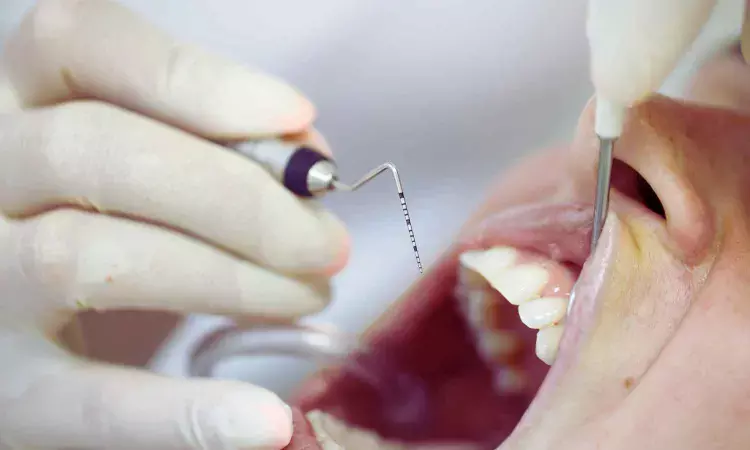- Home
- Medical news & Guidelines
- Anesthesiology
- Cardiology and CTVS
- Critical Care
- Dentistry
- Dermatology
- Diabetes and Endocrinology
- ENT
- Gastroenterology
- Medicine
- Nephrology
- Neurology
- Obstretics-Gynaecology
- Oncology
- Ophthalmology
- Orthopaedics
- Pediatrics-Neonatology
- Psychiatry
- Pulmonology
- Radiology
- Surgery
- Urology
- Laboratory Medicine
- Diet
- Nursing
- Paramedical
- Physiotherapy
- Health news
- Fact Check
- Bone Health Fact Check
- Brain Health Fact Check
- Cancer Related Fact Check
- Child Care Fact Check
- Dental and oral health fact check
- Diabetes and metabolic health fact check
- Diet and Nutrition Fact Check
- Eye and ENT Care Fact Check
- Fitness fact check
- Gut health fact check
- Heart health fact check
- Kidney health fact check
- Medical education fact check
- Men's health fact check
- Respiratory fact check
- Skin and hair care fact check
- Vaccine and Immunization fact check
- Women's health fact check
- AYUSH
- State News
- Andaman and Nicobar Islands
- Andhra Pradesh
- Arunachal Pradesh
- Assam
- Bihar
- Chandigarh
- Chattisgarh
- Dadra and Nagar Haveli
- Daman and Diu
- Delhi
- Goa
- Gujarat
- Haryana
- Himachal Pradesh
- Jammu & Kashmir
- Jharkhand
- Karnataka
- Kerala
- Ladakh
- Lakshadweep
- Madhya Pradesh
- Maharashtra
- Manipur
- Meghalaya
- Mizoram
- Nagaland
- Odisha
- Puducherry
- Punjab
- Rajasthan
- Sikkim
- Tamil Nadu
- Telangana
- Tripura
- Uttar Pradesh
- Uttrakhand
- West Bengal
- Medical Education
- Industry
3D Imaging exhibits Enhanced Accuracy compared to 2D imaging in Periodontal and Implant Measurements: Study

Researchers have found in a new study that 3D imaging demonstrates superior accuracy and precision compared to traditional 2D imaging and intra-surgical measurement techniques, particularly in evaluating horizontal and vertical disc or plane dimensions. Its advanced spatial capabilities make it a valuable tool for detailed anatomical assessments. However, current findings indicate no significant advantage in measuring furcation height, width, and depth, highlighting the need for further research in these specific areas to determine their full clinical utility.
The present systematic review and meta-analysis aimed to compare the efficacy of three-dimensional (3D) imaging techniques in terms of accuracy and precision for periodontal disease assessment. A literature search was conducted across multiple databases (PubMed, Scopus, Web of Science, Google Scholar, and ScienceDirect) following Preferred Reporting Items for Systematic Reviews and Meta-analysis (PRISMA) protocols.
The primary outcomes focused on comparing the accuracy and precision of 3D versus two-dimensional (2D) imaging techniques. Furthermore, it assessed their performance in determining periodontal diseases. Quality assessment was performed using the risk of bias (RoB)-2 for randomized controlled trials (RCTs) and ROB in nonrandomized studies-Intervention (ROBINS-I) for non-RCTs. Meta-analysis was conducted using RevMan 5.4 with a significance level set at 0.01. While meta-regression was performed using OpenMEE.
Results: After screening, 22 studies met the eligibility criteria for qualitative and quantitative analysis. Qualitatively, 3D imaging, particularly cone-beam computed tomography (CBCT), showed superior accuracy and precision over 2D techniques. The meta-analysis revealed significant differences in several areas: overall (p = 0.00001, Mean Difference (MD) = −0.36, 95% confidence interval [CI]: −0.96 to 0.24, I² = 93%), horizontal measurements (p = 0.00001, MD = −0.75, 95% CI: −2 to −0.49, I² = 92%), and vertical measurements (p = 0.00001, MD = −0.59, 95% CI: −2.40 to 1.23, I² = 92%).
Nonsignificant differences were found for furcation height, width, and depth. Most studies showed good quality with a low risk of bias. Age of the participants and study quality were found to be the sources of heterogeneity. Consistent trends highlight the advantages of 3D imaging in assessing both periodontal and nonperiodontal diseases. However, given the nonsignificant differences in furcation height, width, and depth, the recommended approach is to combine CBCT with digital intraoral radiography for more comprehensive periodontal bone assessment.
Reference:
Saini, R.S., Vaddamanu, S.K., Kanji, M.A., Mosaddad, S.A. and Heboyan, A. (2025), Comparative Analysis of 3D Imaging in Periodontal Disease Assessment: A Systematic Review and Meta-Analysis. Clinical and Experimental Dental Research, 11: e70169. https://doi.org/10.1002/cre2.70169
Dr. Shravani Dali has completed her BDS from Pravara institute of medical sciences, loni. Following which she extensively worked in the healthcare sector for 2+ years. She has been actively involved in writing blogs in field of health and wellness. Currently she is pursuing her Masters of public health-health administration from Tata institute of social sciences. She can be contacted at editorial@medicaldialogues.in.
Dr Kamal Kant Kohli-MBBS, DTCD- a chest specialist with more than 30 years of practice and a flair for writing clinical articles, Dr Kamal Kant Kohli joined Medical Dialogues as a Chief Editor of Medical News. Besides writing articles, as an editor, he proofreads and verifies all the medical content published on Medical Dialogues including those coming from journals, studies,medical conferences,guidelines etc. Email: drkohli@medicaldialogues.in. Contact no. 011-43720751


